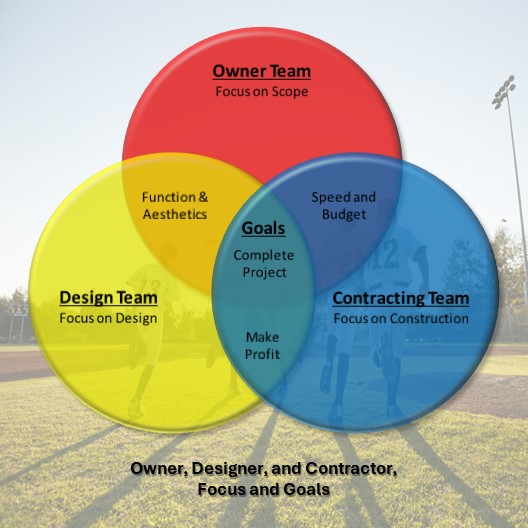Construction projects often go over budget
Studies show approximately 85% of projects go over budget an average of 28% (Propeller). Large projects are particularly susceptible, often taking 20% longer than expected to finish, and going over budget as much as 80%(McKinsey and Company). However, most people trying to address the issue fail to truly understand why construction projects go over budget.
Several factors influence cost overruns including poor project scope definition, unforeseen changes during the project, and mismanagement. (Propeller)
These statistics highlight the challenges in managing construction projects effectively. They underscore the need for improved planning, communication, and use of technology to mitigate these risks.
Team Focus and Goals
Let us explore why this happens and how it manifests, by examining relationships through each Team’s Focus and Goals.
First, it helps to think about Owners, Designers, and Contractors as separate Teams. Doing so reminds us that Teams do not all share the same Focus or Goals, nor to the same degree. Each Team wants to Complete the Project but that is not their only Goal and their Goals are not always aligned.

Inset: There are three Teams each with their own Focus, sharing
three Goals to varying degrees. Each Team shares two Goals, and no two Teams
share all Goals.
Teams have different focus and goals
Owners have a vision and Focus on their Scope, and Budget. They want the project to be Functional and Aesthetically pleasing and on budget. They rely on Designers to focus on turning that vision into buildable and compliant construction documents. Designers may also observe construction and respond to questions, but Construction is someone else’s responsibility.
Contractors focus on building what’s in the plans as quickly as possible. They’ll tell you if there is a problem and when something will take longer, but Design is someone else’s responsibility. Designers and Contractors both, want to make a profit. They can get more antagonistic and want to spend less time when they feel they are not making money.
Opposing goals increase costs
Where the Owner, Designer and Contractor Goals intersect, conflicts of interest await, that only appear when one Goal opposes another. Because projects take months or years to plan and finish, problems often go unnoticed until an issue occurs during construction.
Owners know what they need, want, and wish to build to varying degrees. However, owner’s typically lack a comprehensive understanding of design and construction and how to manage them. AIA contracts place Designers at the lead of the process. But is the Fox Watching the Henhouse when construction challenges threaten to expose errors, omissions, deficiencies, and adds costs?
When misunderstandings between Owners and Designers occur, Owners vision or budgets are not accurately represented in the design. Commonly resulting in additional design costs and compromises during construction.
Construction reveals unknown site conditions, and unresolved, unrecognized, deflected, or deferred issues, which engender conflict between design and construction. The Owner’s job is to navigate and negotiate the conflicts between design and construction. This often puts owner’s in the position of having to choose between two plausible, commonly conflicting solutions. The choice typically requires adjustments to plans and slows construction. Forcing contractors to find ways to stay on schedule, submit change orders, and deflect blame. All of which, makes construction projects go over budget.
The result
This process repeats countless times, which is why 85% of construction projects go over budget. Whether by traditional Design-Bid-Build or it’s contemporary Design-Build delivery methods. This problem is endemic to the industry. It arises from differences in how Teams work and think, and how legalities have required them to structure their roles.
The result is 30% of construction projects end up in dispute, which can lead to litigation (AEC Profiles). The construction industry is highly litigious for multiple reasons; the complex nature of contracts, challenges that arise during construction, misunderstandings, nonpayment, and poor workmanship (Viewpoint | Trimble). Most disputes get resolved out of court, but there is a trend towards more claims ending up in litigation (PlanRadar).
Total value of overruns
The total value of put-in-place construction in the U.S. was approximately $2.03 trillion for 2023 (ACEC). Considering about 85% of projects go over budget an average 28% (Propeller), let’s estimate the total value using this formula:
Estimated Overruns = $2.03 trillion X 85% X 28% =
Using this formula, we see there was about $483.14 billion in cost overruns for U.S. construction projects in 2023.
The solution to reducing overruns
The best way to ensure projects do not go over budget, is to remove the conflicts of interest inherent to construction. We can do that by using an Owner’s Representative to manage the project program, design and construction teams, and advocate for the best interest of the owner. An Owner’s Representative (OR) provides various services that helps everyone on the project. The OR helps the Owner prioritize and budget the entire project program. Helps Designers maximize creativity and efficiency. And they negotiate design and construction conflicts, to pave the way for Construction to move quickly toward completion.
Specific statistics on the percentage of construction projects that use owner representation and end up in litigation isn’t currently available. The information available focuses on their roles and responsibilities and how they influence the project outcome.
Owner’s representatives play a significant role in managing and mitigating risks throughout the construction process. They provide services that ensure contract performance, provide project management and oversight, facilitate communication, and can help negotiate and resolve disputes before escalating to litigation. (American Bar Association) (American Bar Association) (KPPB LAW)
Find an owner’s representative near you to help keep your project predictable and controlled, and form being one of 85% of projects that went over budget 28% or more.